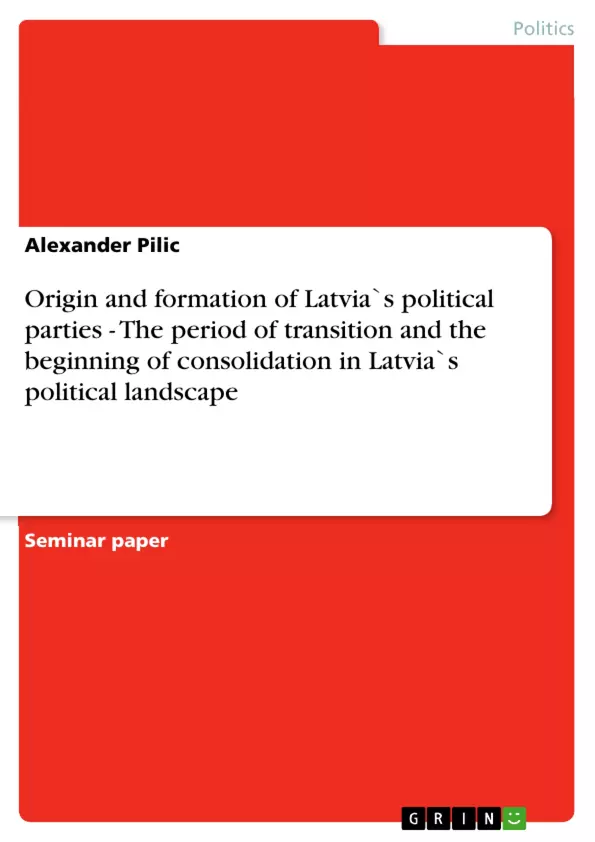After a short period of being a liberal democracy in the 1920´s, Latvia was ruled by totalitarian regimes, beginning with the dictatorship of Ulmanis and the following German occupation of the country to almost fifty years of Soviet rule which ended officially on September 6th, 1991 when the Soviet Union recognized all three Baltic states as independent.
In the aftermath, Latvia found itself in a process of transition which lasts for one decade now.When the people of Latvia were able to participate in the first partly free elections in 1989 they chose almost exclusively candidates of their main opposition movement Popular Front (LTF) to represent Latvia´s interests within Moscow´s Congress of the People´s Deputies. Just one year later, the last elections under Soviet rule took place on the national level in Latvia. The Popular Front finished first and governed Latvia on it´s way towards independence. As soon as the LTF was freed from the big pressure under which it had fought for democracy against the powerful Kremlin it became obvious that the Popular Front consisted of very different political groups ranging from former communist party members to Latvian nationalists.
Some parties were very popular during one election, but in the next one they could not collect enough votes to get into parliament. Some parties collapsed after a short period of time, others split into new movements or merged with other parties. No coalition-government lasted for the whole parliamentary term and in each of the three elections during the nineties more than one half of the participating parties took part for the first time. On the other hand, especially during the last two years some small parties merged into larger ones or at least formed joined factions in parliament and lists in the elections. This development could be considered as a step towards larger and more significant parties which would lead to more stability within Latvia´s political landscape.
In order to find out whether there is a tendency for consolidation among political parties I will concentrate this essay in first place on their process of formation since the beginning of Latvia´s democratization in the late eighties. Furthermore, I will link the parties´ genesis with their roles in parliament and administration to explain their significance for Latvian politics. In my conclusion I will summarize the collected data in order to give an answer to the examined issue.
Inhaltsverzeichnis (Table of Contents)
- 1. Introduction
- 2. Historical Review
- 3. The Origin of Latvia´s Parties
- 3.1 From Perestroika to Independence
- 3.2 The period of party-building
- 4. Latvia's parties on their way to more stability
- 5. Conclusion
Zielsetzung und Themenschwerpunkte (Objectives and Key Themes)
This essay analyzes the formation and development of political parties in Latvia since the country gained independence in 1991. It examines the role of these parties in the country's transition to democracy and assesses whether there is a tendency for consolidation within the Latvian political landscape.
- The emergence of a multi-party system in Latvia after the fall of the Soviet Union
- The influence of historical factors, including the interwar period and the Soviet era, on Latvian political parties
- The dynamics of party formation, development, and stability in the early years of Latvian independence
- The role of parties in shaping the political landscape and governance of Latvia
- The potential for consolidation among Latvian political parties
Zusammenfassung der Kapitel (Chapter Summaries)
The first chapter introduces the topic of political transition in Latvia and provides background information on the country's history, including its Soviet period and the events leading to independence. It highlights the significance of political freedom and the emergence of the Popular Front (LTF) as a major force in the struggle for independence. The chapter also discusses the formation of a multi-party system in the early 1990s, highlighting the influence of various political groups, including former communist party members, Latvian nationalists, and the Latvian National Independence Movement (LNNK). The second chapter delves into the historical context of Latvia's political development, drawing comparisons between the present and the "Interwar-Period" between World War I and World War II. It analyzes the influence of the first Latvian republic on today's political landscape and emphasizes the significance of the Satversme, the first Latvian constitution. The chapter also discusses the agrarian reforms, minority-laws, and the role of various political parties, including the Farmer's Union, the Social-Democrats, and the Democratic Center Party, during the early years of independence. It concludes with an overview of the challenges faced by the first republic, including the emergence of instability and a decline in confidence in democracy.
Schlüsselwörter (Keywords)
The main focus of this essay is the formation and development of political parties in Latvia, their role in the country's transition to democracy, and the potential for consolidation within the Latvian political landscape. Key themes include the emergence of a multi-party system, the influence of historical factors, the dynamics of party formation, and the impact of parties on Latvian politics.
- Quote paper
- Alexander Pilic (Author), 2000, Origin and formation of Latvia`s political parties - The period of transition and the beginning of consolidation in Latvia`s political landscape, Munich, GRIN Verlag, https://www.grin.com/document/9985



